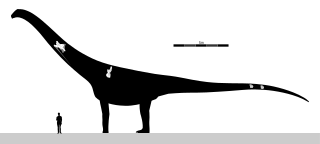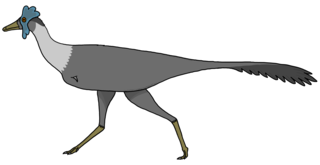
Titanosaurs were a diverse group of sauropod dinosaurs, including genera from all seven continents. The titanosaurs were the last surviving group of long-necked sauropods, with taxa still thriving at the time of the extinction event at the end of the Cretaceous. This group includes some of the largest land animals known to have ever existed, such as Patagotitan—estimated at 37 m (121 ft) long with a weight of 69 tonnes —and the comparably-sized Argentinosaurus and Puertasaurus from the same region.

Aeolosaurus is a genus of titanosaurian sauropod dinosaur from the Late Cretaceous Period of what is now South America. Like most sauropods, it would have been a quadrupedal herbivore with a long neck and tail. Aeolosaurus is well known for a titanosaur, as it is represented by the remains of several individuals belonging to at least two species. However, like most titanosaurs, no remains of the skull are known. The holotype of Aeolosaurus rionegrinus consists of a series of seven tail vertebrae, as well as parts of both forelimbs and the right hindlimb. It was discovered in the Angostura Colorada Formation in Argentina, which dates from the Campanian stage of the Late Cretaceous, about 83 to 74 million years ago. The species A. maximus was transferred over to the new genus Arrudatitan in 2021.
Bonatitan is a genus of titanosaurian dinosaur from the Late Cretaceous Allen Formation of Argentina. It was named in 2004.

Quilmesaurus is a genus of carnivorous abelisaurid theropod dinosaur from the Patagonian Upper Cretaceous of Argentina. It was a member of Abelisauridae, closely related to genera such as Carnotaurus. The only known remains of this genus are leg bones which share certain similarities to a variety of abelisaurids. However, these bones lack unique features, which may render Quilmesaurus a nomen vanum.

Andesaurus is a genus of basal titanosaurian sauropod dinosaur which existed during the middle of the Cretaceous Period in South America. Like most sauropods, belonging to one of the largest animals ever to walk the Earth, it would have had a small head on the end of a long neck and an equally long tail.
Mendozasaurus is a genus of titanosaurian sauropod dinosaur. It was a member of Titanosauria, which were massive sauropods that were common on the southern landmasses during the Cretaceous. It is represented by several partial skeletons from a single locality within the Coniacian Sierra Barrosa Formation in the south of Mendoza Province, northern Neuquén Basin, Argentina. The type species, Mendozasaurus neguyelap, was described by Argentine paleontologist Bernardo Javier González Riga in 2003. Mendozasaurus is the first dinosaur named from Mendoza Province, Argentina, for which it was named.

Pellegrinisaurus is a genus of titanosaurian sauropod dinosaur that lived in South America during the Late Cretaceous period. The holotype was found in the Allen Formation, Argentina.

Rinconsaurus is a genus of titanosaur sauropod dinosaur from the Late Cretaceous in what is now Argentina. The type species, Rinconsaurus caudamirus, was described by Calvo and Riga in 2003, and is based on three partial skeletons.

The Anacleto Formation is a geologic formation with outcrops in the Argentine Patagonian provinces of Mendoza, Río Negro, and Neuquén. It is the youngest formation within the Neuquén Group and belongs to the Río Colorado Subgroup. Formerly that subgroup was treated as a formation, and the Anacleto Formation was known as the Anacleto Member.

Puertasaurus is a genus of sauropod dinosaur that lived in South America during the Late Cretaceous Period. It is known from a single specimen recovered from sedimentary rocks of the Cerro Fortaleza Formation in southwestern Patagonia, Argentina, which probably is Campanian or Maastrichtian in age. The only species is Puertasaurus reuili. Described by the paleontologist Fernando Novas and colleagues in 2005, it was named in honor of Pablo Puerta and Santiago Reuil, who discovered and prepared the specimen. It consists of four well-preserved vertebrae, including one cervical, one dorsal, and two caudal vertebrae. Puertasaurus is a member of Titanosauria, the dominant group of sauropods during the Cretaceous.

The Allen Formation is a geological formation in Argentina whose strata date back to the Late Cretaceous (middle Campanian to early Maastrichtian. Dinosaur remains are among the fossils that have been recovered from the formation. Indeterminate chelid remains and other vertebrates have also been discovered in this formation.
Traukutitan is a genus of titanosaur sauropod dinosaur which lived during the late Cretaceous.

Bonapartenykus is a monospecific genus of alvarezsauroid dinosaur from Argentina that lived during the Late Cretaceous (Campanian-Maastrichtian) in what is now the upper Allen Formation of the Río Negro Province. The type and only species, Bonapartenykus ultimus, is known from a nearly articulated but partial skeleton that was found in close association to two incomplete eggs and several clusters of eggshells belonging to the oogenus Arriagadoolithus. Bonapartenykus was named in 2012 by Federico L. Agnolin, Jaime E. Powell, Fernando E. Novas and Martin Kundrát. Bonapartenykus has an estimated length of 2.5 m (8.2 ft) and weight of 72 kg (159 lb), making it the largest member of the clade Alvarezsauroidea.

Eutitanosauria is a clade of titanosaurs, encompassing the more derived members of the group and characterized by the absence of the hyposphene-hypantrum articulation and possibly the presence of osteoderms. The group was first named by Sanz and colleagues in 1999, who used it to unite the group of Argyrosaurus, Lirainosaurus, Saltasaurus and the Peiropolis titanosaur. However, this definition was not used as it made the group equivalent to Saltasauridae, so Saldago redefined it in 2003 to be all titanosaurs closer to Saltasaurus than Epachthosaurus. This definition created Eutitanosauria as the sister group to Epachthosaurinae, but was problematic due to the variable nature of Epachthosaurus. Eutitanosauria was often broadly similar to Lithostrotia, and has often been unused or unlabelled on phylogenies. Sometimes Epachthosaurus would be more primitive than Malawisaurus, making Eutitanosauria more encompassing than Lithostrotia, or Epachthosaurus could nest close to Colossosauria and limit Eutitanosauria to a smaller group of saltasauroids. Because of the flexible nature of Epachthosaurus in basal titanosaur phylogeny, Carballido and colleagues redefined the group in 2022 to include the smallest clade of both Patagotitan, a colossosaur, and Saltasaurus, creating a node-stem clade with Colossosauria and Saltasauroidea, presenting the informal cladogram of stable titanosaur clades below.
Choconsaurus is an extinct genus of herbivorous sauropod dinosaur belonging to the group Titanosauriformes, which lived in the area of present-day Argentina at the end of the Cretaceous.

Niebla is a genus of abelisaurid theropod dinosaur from the Late Cretaceous Period (Campanian-Maastrichtian) of Río Negro province, Argentina. The genus contains a single species, Niebla antiqua, and is known from a partial, non-articulated skeleton. The holotype, found in the Allen Formation, represents an adult individual.
Menucocelsior is a genus of medium-sized titanosaurian sauropod dinosaur from the Late Cretaceous Allen Formation of Argentina. The type and only species is Menucocelsior arriagadai.
Teratopodus is an ichnogenus of titanosaurian sauropod footprint. It includes a single species, T. malarguensis, known from prints found in the Late Cretaceous Anacleto Formation of Argentina. The Teratopodus tracks represent some of the best sauropod pes tracks currently known from South America.
Patagopelta is an extinct genus of ankylosaurian dinosaur from the Late Cretaceous Allen Formation of Argentina. The genus contains a single species, P. cristata, known from a partial skeleton. While originally described as a nodosaurine, later discoveries provided support for parankylosaurian affinities for the taxon. Patagopelta is a very small ankylosaur, comparable in size to the dwarf nodosaurid Struthiosaurus, about 2 m (6.6 ft) long.























